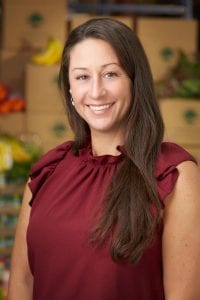Was Normal Good Enough?
February 18, 2022By Erinn Rowe
CEO
Harvest Hope Food Bank
As the CEO of Harvest Hope Food Bank, I have seen the impact of the COVID-19 pandemic firsthand. I have seen a lot of families struggling. I have seen sadness from a parent stressed to feed their children. I have had a mom crying to me because they just didn’t know what else to do. It’s been a lot.
Almost every interview I give or conversation I have, one question keeps coming up: When will we get back to normal? Everyone wants to know. When will we go back to the way it was? Are you starting to see a decline to pre-COVID numbers? Are we going back to the way we were? Are we back to normal?
Those are tough questions to answer, and I’ve challenged each with my own question: was normal ever good enough? Was normal good enough to be our goal now?
When we were normal, according to the Census, in 2020 over 37 million people lived in poverty. Feeding America’s Food Insecurity data states that in 2019 there were 35,207,000 who were food insecure. 50% of the United States falls below the SNAP threshold of 130% the poverty rate.
FBI statistics show that hate crime rates based on race, ethnicity, religion, or ancestry continue to be the biggest area of concern across the country. In total, 3,963 incidents related to race, ethnicity, and ancestry were reported in 2019. Those were just the reported incidents.
Climate change escalated to such a point that in 2019 the Department of Defense created a report that stated climate change was a national security issue with potential impacts to DoD missions, operational plans, and installations. The same year a group of U.S. Senators wrote to Chairman Powell of the Federal Reserve urging him to ensure the U.S. financial system “is prepared for the risks associated with climate change”.
Are you beginning to see the picture I’m painting? Was normal good enough? Are we willing to settle for normal again? Are you? Don’t let normal be good enough.
One of my favorite words is grit. By definition, grit is a diligent spirit; the nagging conviction that keeps you pressing on when it’d be easier to give up. Grit is the realization that achieving one’s greatest potential comes from running a marathon, not a sprint.
At Harvest Hope, our vision is a hunger-free South Carolina. That is the normal we are striving for. Sometimes when I drive into the facility, I pass literally 150 cars lined up waiting for the emergency food pantry to open—and our pantry is just one of over 350 pantries we service in the state. It can be so overwhelming to know that we as an organization can’t miss the mark. Our staff get weary and sometimes we fail. I ensure them daily that we can do this. We have grit. We will continuously improve how we approach hunger in SC because we want our new normal to be a hunger-free state.
If the new normal seems so far out of reach from where we are today as a society, if it feels insurmountable, have grit. Break it down to what you can control today. Who, in your circle of influence, can you impact? And then do it.
Humans have the most amazing resiliency. If we as a society decide that normal is not good enough, that normal is not what we want for our kids and grandkids, then let’s decide to make a new normal.
About Harvest Hope Food Bank
Harvest Hope is building a hunger-free tomorrow in 20 counties across South Carolina. Rescuing food from stores that is at risk of being discarded, as well as sourcing food from the community and producers, they distribute it to local food pantries and through multiple feeding programs. These programs provide food for some of SC’s most vulnerable citizens – children, seniors, and rural residents who don’t have access to reliable transportation to grocery stores. Annually, Harvest Hope provides over 22 million meals to neighbors in need across their service area. Learn more at harvesthope.org.














